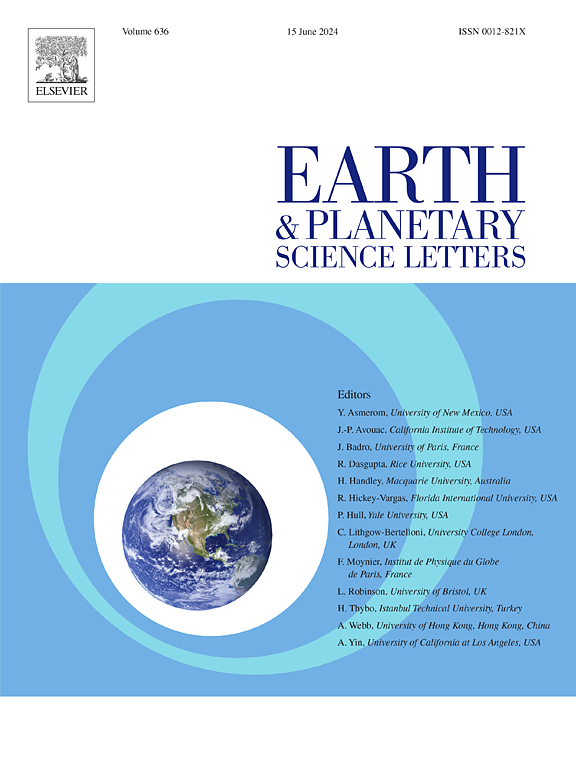Closing the oceanic lithium budget by continental shelf sediment removal
IF 4.8
1区 地球科学
Q1 GEOCHEMISTRY & GEOPHYSICS
引用次数: 0
Abstract
Seawater lithium isotopes (δ7LiSW) are increasingly used as a proxy for continental silicate weathering and marine reverse weathering throughout Earth’s history. However, the mechanisms driving δ7LiSW evolution remain uncertain, partly due to insufficient constraints on modern Li sources and sinks. Among these, sediment diagenesis has long been identified as an important Li sink, yet direct and quantitative evaluations of global authigenic Li sink remains limited. Here, we present porewater data to explore the controls on porewater Li distribution and to directly quantify Li removal and isotopic fractionation in shelf sediments. We find that Li removal associated with marine authigenic clay (MAAC) formation in shelf sediments is not limited by Si(OH)4 because of its sufficient supply from the dissolution of terrigenous reactive aluminosilicates and biogenic silica. We show that irrigation-enhanced transport, coupled with active Li removal into authigenic clays in shelf sediments, result in a flux of 21±8 G mol year-1, suggesting that Li removal associated with MAAC formation in shelf sediments is the dominant Li sink from seawater. We further constrain an isotopic fractionation (ΔSW−MAAC=δ7LiSW-δ7LiMAAC) of 14.7–16.5 ‰ associated with this irrigation-enhanced shelf sediment sink. Our results highlight that authigenic Li removal into shelf sediments, complemented by a smaller contribution from seafloor basalt alteration, can closely balance the oceanic Li sources and have profound implications for understanding authigenic clay formation and Li cycle in the ancient ocean.
通过移除大陆架沉积物关闭海洋锂收支
在地球历史上,海水锂同位素(δ7LiSW)越来越多地被用作大陆硅酸盐风化和海洋反向风化的代表。然而,驱动δ7LiSW演化的机制仍然不确定,部分原因是对现代Li源和汇的限制不够。其中,沉积成岩作用一直被认为是重要的锂汇,但对全球自生锂汇的直接定量评价仍然有限。本文利用孔隙水数据探讨孔隙水中Li分布的控制因素,并直接量化陆架沉积物中Li的去除和同位素分馏。我们发现陆架沉积物中与海相自生粘土(MAAC)形成相关的Li去除不受Si(OH)4的限制,因为它的充足供应来自陆源活性硅铝酸盐和生物硅的溶解。研究表明,在陆架沉积物中,灌溉增强的运输,加上Li在自生粘土中的主动去除,导致通量为21±8 G mol /年1,这表明与陆架沉积物中MAAC形成相关的Li去除是海水中主要的Li汇。我们进一步约束了14.7 ~ 16.5‰的同位素分馏(ΔSW−MAAC=δ7LiSW-δ7LiMAAC)与这个灌溉增强的陆架沉积物汇有关。我们的研究结果表明,陆架沉积物中的自生Li迁移,加上海底玄武岩蚀变的较小贡献,可以密切平衡海洋Li来源,并对理解古海洋自生粘土形成和Li循环具有深远的意义。
本文章由计算机程序翻译,如有差异,请以英文原文为准。
求助全文
约1分钟内获得全文
求助全文
来源期刊

Earth and Planetary Science Letters
地学-地球化学与地球物理
CiteScore
10.30
自引率
5.70%
发文量
475
审稿时长
2.8 months
期刊介绍:
Earth and Planetary Science Letters (EPSL) is a leading journal for researchers across the entire Earth and planetary sciences community. It publishes concise, exciting, high-impact articles ("Letters") of broad interest. Its focus is on physical and chemical processes, the evolution and general properties of the Earth and planets - from their deep interiors to their atmospheres. EPSL also includes a Frontiers section, featuring invited high-profile synthesis articles by leading experts on timely topics to bring cutting-edge research to the wider community.
 求助内容:
求助内容: 应助结果提醒方式:
应助结果提醒方式:


